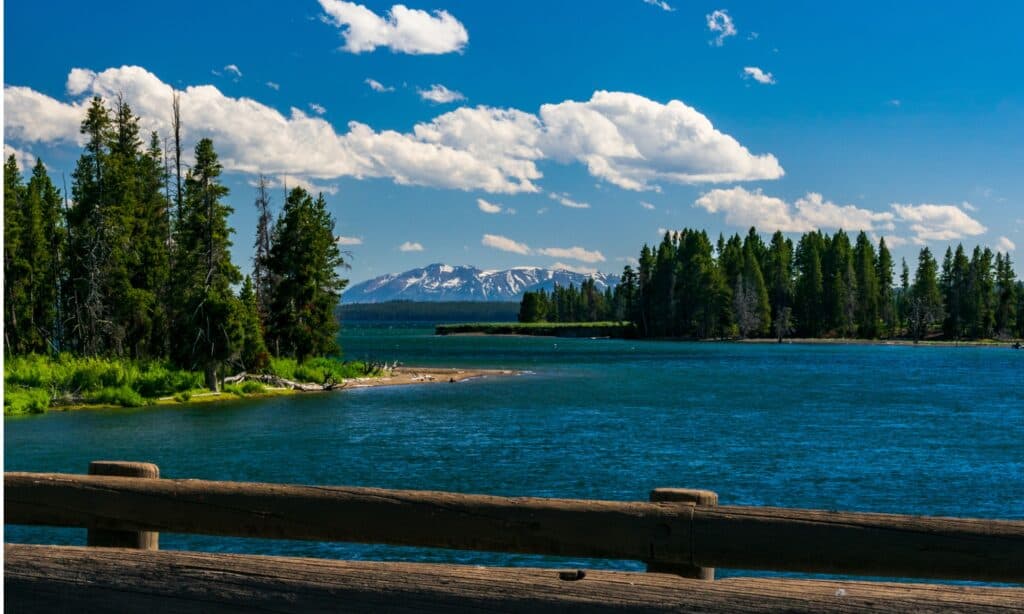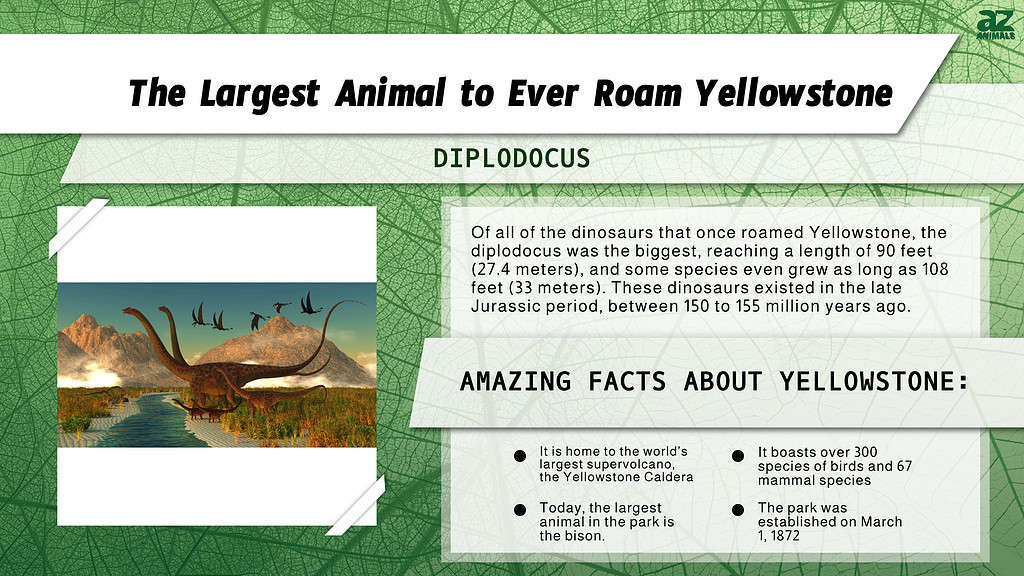There are hundreds of national parks scattered worldwide, and the majority are home to some of the largest and most fearsome predators that have ever walked the earth. Yellowstone National Park is sometimes called the oldest national park in the world, and rightfully so. Have you ever wondered about the largest animals to ever roam the popular Yellowstone National Park?
In this article, we will discuss the history of Yellowstone National Park, what animals could have lived there, and what the largest animal to ever roam the park is.
History of Yellowstone National Park

Yellowstone National Park is home to the world’s largest supervolcano, the Yellowstone Caldera.
©iStock.com/T Schofield
Yellowstone National Park sits in the western United States, with most parts in the northwest corner of Wyoming, extending into Montana and Idaho. With the Yellowstone National Park Protection Act, the national park was created by the 42nd United States Congress. It was signed into law by President Ulysses S. Grant on March 1, 1872, making it the first national park in the United States and the world. Before being made into a national park, Native Americans lived in the Yellowstone area for at least 11,000 years, with enough evidence found in trails, archeological sites, and oral histories, making it easy for the park’s visitors to learn more about the people that once lived there. The park got its name from the Yellowstone River, which was named after the yellow rocks found in the Grand Canyon of Yellowstone.
Aside from the evidence of the presence of human life in the park before civilization, there is also evidence of obsidian, also dating as far back as 11,000 years. Yellowstone National Park is home to the world’s largest supervolcano, the Yellowstone Caldera, located in the northwest corner of Wyoming. This supervolcano is measured at 43 by 28 miles (70 by 45 km) and has not erupted in about 70,000 years. Underneath the supervolcano is magma that makes geysers and colorful hot springs, making Yellowstone National Park the world’s largest concentration of geysers and hydrothermal systems.
The Largest Animal To Ever Roam Yellowstone National Park

The diverse and abundant wildlife in Yellowstone National Park is as famous as the park’s geysers. The park boasts over 300 species of birds, 67 species of mammals, 16 species of fish, six species of reptiles, and five species of amphibians, among others. Although there are animals all around the park, the likelihood of seeing some animals when visiting depends on the animals’ preferred habitat and seasonal cycle of movement.
The beautiful park is home to wildlife of different kinds and behavioral patterns, with most being unpredictable and dangerous, particularly mothers with their young. For safety reasons, it is necessary to observe these animals from a safe distance without making any attempt to disturb them or cause them to attack.
Yellowstone National Park is popular for many reasons, like the scenery, geysers, hot springs, and the numerous wildlife that inhabit the park. There is a portion of the national park, though, that many people do not know about; the existence of fossils in and around the park. Not too far from Yellowstone National Park is the Wyoming Dinosaur Center, a non-profit organization devoted to preserving Wyoming’s natural history and providing a paleontological experience for its visitors. The center is home to some of the largest and most unique dinosaur fossil collections in the world, providing visitors the firsthand experience of digging up fossils in areas with over 15,000 dinosaur bones discovered.
Yellowstone National Park is home to a variety of dinosaur fossils, with several body fossils like bones and trail fossils like footprints and trackways. There are also fossils of unique petrified forests, some having multiple layers of buried forests, sometimes reaching up to 50 layers. Despite the large number of dinosaur fossils that have been found, scientists have been studying the bones of the four most common dinosaur species found in the park, Diplodocus, Allosaurus, Apatosaurus, and Camarasaurus, since the 1870s.
Of these four commonly found dinosaur fossils, the diplodocus was the biggest, reaching a length of 90 feet (27.4 meters), and some species even grew as long as 108 feet (33 meters). These dinosaurs existed in the late Jurassic period, between 150 to 155 million years ago. The Apatosaurus grew as long as 75 feet (23 meters) and as tall as 30 feet, weighing up to 45 tons. Most Camarasaurus species grew as long as 49 to 59 feet (18 meters), but the largest species were as long as 75 feet (23 meters) and weighed up to 51.8 tons. The smallest of the four common dinosaur fossils found in the park is the Allosaurus, which was as long as 38 feet and as tall as 16.5 feet. This species also had a skull length of around three feet.
The Current Largest Animal in Yellowstone National Park

Bison are the largest animals in Yellowstone National Park.
©iStock.com/Jillian Cooper
When it comes to scenic splendor, recreational activities, and wildlife viewing, Yellowstone National Park is a wonderland. Yellowstone is home to the highest number of different mammal species in the United States, including several that have only ever been reintroduced into the Yellowstone ecosystem. In the lower 48 states, Yellowstone National Park boasts the highest concentration of animals. Visitors to Yellowstone are especially interested in seeing bears, wolves, moose, elk, bison, badgers, otters, foxes, and any young wildlife.
The park is home to almost 70 mammal species including wolverine and lynx, over 500 grizzly bears (aside from black bears), almost 400 gray wolves, and seven native species of ungulates – elk, mule deer, bison, moose, bighorn sheep, pronghorn, and white-tailed deer, including one of the largest herds of elk in the United States.
Currently, the largest animal in Yellowstone National Park is the bison. American bison are revered for their size and history. Since it is impossible to visit Yellowstone without seeing at least one bison, they are also recognized by many visitors and park rangers as the park’s mascot. Apart from being the park’s mascot, they are also the most notorious animals in the park and also the biggest. Depending on gender, the average bison reaches anywhere from 8-10 feet long and weighs as much as 1000 to 2000 pounds. As such, it is necessary to maintain a distance from them at all times.
What Other Large Animals Live in Yellowstone Park?

Elks are capable of reaching 700lbs in weight and are one of the park’s largest residents
©Bradley Wakoff/Shutterstock.com
The nation’s oldest park is home to several large animals apart from the mighty bison. These include:
- The brown bear: Yellowstone is home to a population of about 150 of these ambling predators which are significantly larger than their black counterparts. Males are capable of reaching about 700 lbs and over 3 feet at their shoulders.
- The elk: About 10,000 – 20,000 of these giant cervids descend on the park in summer, making the species the most abundant in this select group of mammals in Yellowstone. With males being capable of reaching 700lbs and measuring five feet at the shoulder they’re truly massive.
- The moose: With a population that has declined over decades, the current population of this giant ungulate in the park currently stands at 200. These heavyweights outdo even brown bears and elks in the size stakes with males being able to reach 1,000lbs (rivaling the bison) and a height of 7½ feet at the shoulder.
When Is The Best Time To Visit Yellowstone?
This famous national park is very busy during the summer months, possibly because it can provide great weather and that’s when kids are off of school. But as things shift and the world is even more digital, many families and groups can take advantage of Yellowstone National Park at any time!
The best time to visit is late April to May and September to early October.
Spring weather in Yellowstone can be unpredictable. However, you’ll be able to watch the park emerge from its winter hibernation without the crowds. Average temperatures can fluctuate anywhere between single digits and low 60s, so pack lots of layers! It also gets quite rainy in May, so keep that in mind with your travel timing. Before you travel to Yellowstone, check that the roads are open, which is typically sometime between mid-April and the end of May.
During the warmer months, Yellowstone welcomes more than 2 million visitors so wait it out until early fall. During autumn, the weather is still relatively mild. There are still plenty of wildlife-watching opportunities and many of the crowds have left, leaving reasonably priced accommodations. However, the park will be preparing for winter, so pack accordingly. The average temperatures can range from the mid-30s to low 60s during the day, and nighttime again can see temperatures in the teens and single digits. Sometime in mid-September many facilities close for the year and come mid-October, seasonal road closures start. Research before you make the trip.
The photo featured at the top of this post is © Lillac/Shutterstock.com
Thank you for reading! Have some feedback for us? Contact the AZ Animals editorial team.






